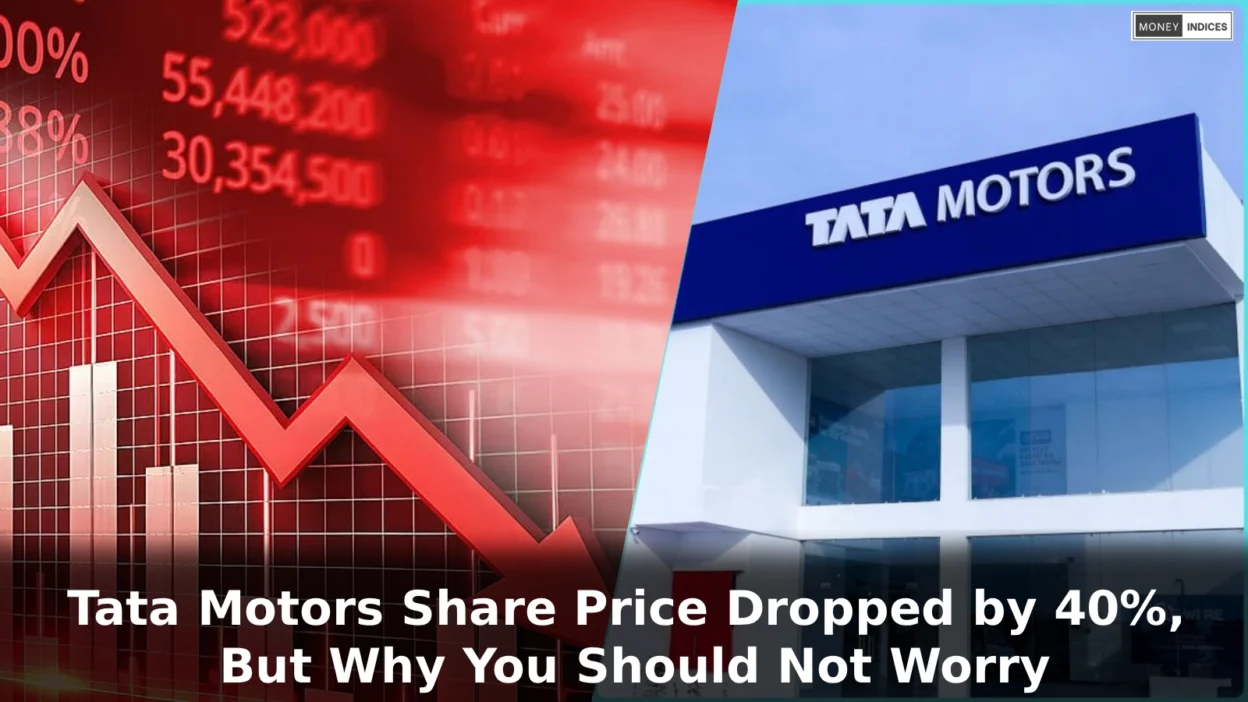If you opened your portfolio today and noticed Tata Motors’ share price plunging by nearly 40%, you might have had a mini heart attack. But before you panic-sell, take a deep breath — this steep drop isn’t what it looks like. The crash is purely technical, linked to the company’s demerger, and not to any fundamental weakness in Tata Motors’ business. Here’s what really happened and why long-term investors need not worry.
The Big Picture: What Happened to Tata Motors Stock?
Tata Motors‘ stock opened at ₹399 on October 14, 2025, down roughly 40% from the close of ₹660.90 on Monday. At first, a lot of traders thought there would be a market crash or bad financial news, but that wasn’t true.
The drop happened because Tata Motors began trading ex-demerger. The company officially split its two core businesses — Passenger Vehicles (PV) and Commercial Vehicles (CV) — into separate listed entities. That means the price adjustment simply reflects the removal of the commercial vehicle business from the original stock value.
So, this is not an erosion of market capital — it’s more like slicing one cake into two equal halves.
Understanding the Tata Motors Demerger
Here’s how the demerger works:
- Tata Motors separated into two companies: Tata Motors Commercial Vehicles Limited (TMLCV) and Tata Motors Passenger Vehicles Limited (TMPVL).
- Shareholders who held Tata Motors shares as of the record date, October 14, will receive one share of the new TMLCV for every one share they already hold in Tata Motors.
- The new CV stock will list on the exchanges in November 2025.
That means your total investment is not lost, but simply split across two companies.
Why Did the Price Drop by 40%?
Before the demerger, Tata Motors’ ₹660 share price represented both businesses combined. After the split, the Passenger Vehicle company (TMPVL) now represents only the PV and JLR arms — naturally, the adjusted price reflects that.
So, the 40% decline mirrors the relative value transferred to the upcoming CV entity. Market capitalization remains almost unchanged, at around ₹1.45 lakh crore.
Simply put, if Tata Motors was an apple worth ₹660, it’s now been divided into two apples worth roughly ₹400 and ₹260 each. You still own both.
Why Investors Should NOT Panic
Several market experts have clarified that this is not an actual crash but a valuation reset after structural reorganization. Your portfolio value will normalize once the CV entity lists publicly.
Here’s why panic selling could be a mistake:
- You still own both companies — Tata Motors PV and Tata Motors CV.
- Fundamentals remain strong, especially in passenger vehicles and EVs.
- Long-term growth story continues, backed by Jaguar Land Rover (JLR) and India’s EV boom.
- The demerser enables strategic focus: CV can dominate logistics and transport solutions, while PV can pursue premium and electric mobility.
To put it simply, this action helps investors in the long run by revealing hidden value in both divisions.
What Happens Next?
- New Stock Listing: Tata Motors Commercial Vehicles Limited (TMLCV) will list by mid-November 2025.
- Value Adjustment: Your Demat account will soon reflect the new shares automatically.
- Performance Focus: TMLCV will continue to produce trucks, buses, and logistics products, while TMPVL will concentrate on producing luxury and electric vehicles.
After both shares are free to trade, the total value ought to once more represent the company’s actual value.
The Long-Term Outlook
Analysts remain positive on Tata Motors post-demerger. The division improves sector-specific growth strategies, management focus, and capital efficiency.
- Passenger Vehicles Arm: Tata Motors anticipates that EV sales will double once more this fiscal year due to the high demand for EVs.
- Commercial Vehicles Arm: The expansion of logistics and investments in infrastructure continue to help the CV company. Demerger independence will facilitate targeted expansion and quicker decision-making.
- JLR Recovery in 2026: Jaguar Land Rover’s production is rebounding after recent setbacks, which should lift consolidated profitability across the group.
Expert View
Market strategists across platforms — from NDTV Profit to Moneycontrol — agree this is a technical correction, not a crash. Investors holding Tata Motors shares as of the record date should sit tight and monitor developments rather than panic.
Both entities are expected to trade at better valuations separately than they did combined.
Key Takeaway
- The 40% fall is due to demerger adjustment, not poor performance.
- Tata Motors’ total market value remains stable.
- Investors will hold shares in both new entities.
- Hold your stock — the long-term potential after the demerger remains strong.
Conclusion
In summary, the 40% decline in Tata Motors‘ stock price is a chance to learn more about how corporate restructuring operates rather than a cause for concern. The business is unlocking its value, not losing it. Tata Motors is establishing two specialized powerhouses that are prepared to expand on their own by splitting its passenger and commercial businesses.
The next time your trading app flashes red, keep in mind that not all dips are bad; some indicate that growth is just getting started.
Follow for more: MoneyIndices!



